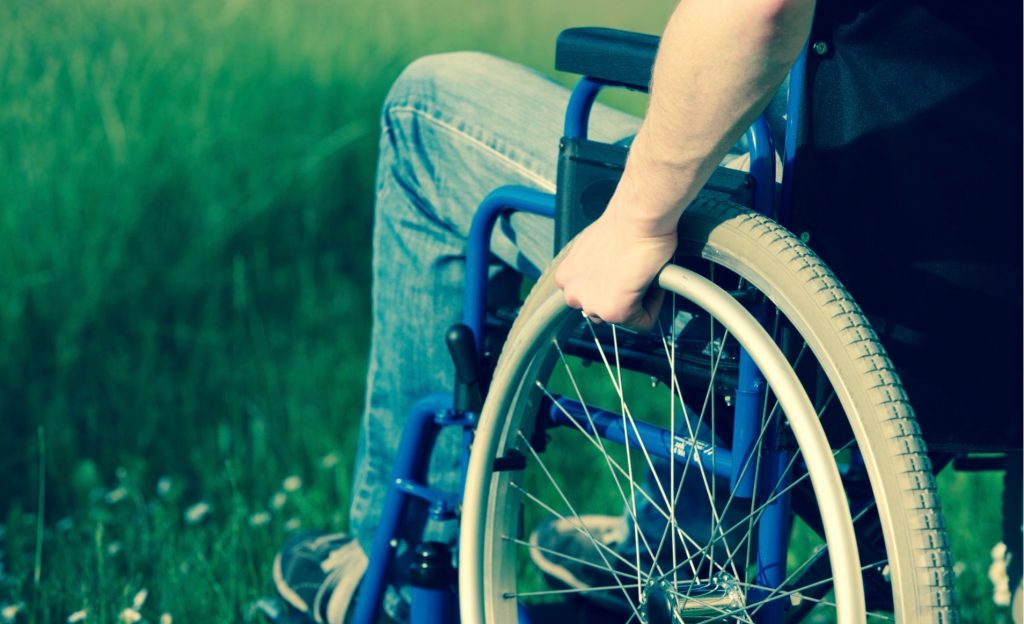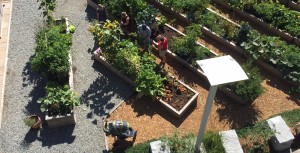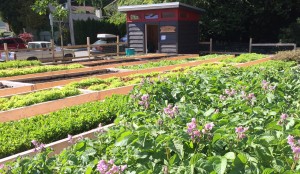
Today, our Foundation is providing easy-to-follow instructions on how you can make your sustainable community gardening system more accessible for all Canadians.
Nearly 14% of all Canadians are living with some form of a disability. While many Canadian communities have come a long way in providing a supportive system for this significant group, a lot can still be done to make gardens more inclusive.
5 Ways to Make Your Urban Farming Project More Accessible for Those with Mobile Disabilities
1. Build Accessible Entryways and Pathways

Apply accessibility best practices to your community garden. There should be no barrier to entry for anyone with a wheelchair, or other devices to assist those with mobility issues. No fence, curb, or protrusion should prevent access to the space. At least one main pathway should be 5-feet wide (60 inches / 152 cm) while other pathways can be a minimum of 3-feet wide to abide by standards.
Path surfaces should have a gradient of 2.5% or less. It must be smooth enough to allow wheelchair navigation. Asphalt and concrete are technically ideal, but may not be realistic for your garden. Instead, you can install or lay compacted crushed stone or brick. Although the upkeep on the bricks is imperative as it tends to shift and crack with frequent traffic. Avoid common community garden path surfacing, including bark mulch, dirt, grass and gravel which prevent the passage of wheelchairs and the like.
Once you’ve provided for accessible entry points and pathways be sure to guide visitors through signage and markers (for larger plots). These will help them know which path/s to follow.
2. Plant Plots with Raised Beds

Garden beds should be enjoyed by all. That means a reasonable percentage can be raised beds, up to 3-feet (36 inches / 91 cm) in height. It’s good to vary raised beds between 2 and 3-feet so that visitors and volunteers of various heights and arm lengths can access crops. Include raised tabletop garden beds too. When tall enough, they allow a wheelchair (and walker) to approach and be tucked under the bed. This allows the visitor/volunteer to get up close to the crops they want to investigate. Signs and markers should be in place to indicate approachability of these tabletop beds, where applicable.
3. Place Seating Areas Around the Garden/Farm
Adding accessible seating to a garden is not just an aesthetic treat. Anyone with limited mobility will appreciate the opportunity to sideline their cane, crutch or walker while they enjoy the garden. There should be enough space on either side of a bench so that someone in a wheelchair can transfer themselves onto the bench without having the chair block the passage for others.
4. Provide Reasonable Access to Water
No community garden or urban farm can thrive without adequate access to water. Visitors and volunteers need to be able to reach taps without discomfort. No excessive bending or reaching should be required. That means taps must be between 2 to 4-feet in height. In addition, small watering containers that can be filled and carried with one hand should be provided. They should be located as close to the water source as much as possible. Garden hoses should be in good order, untangled, and include a nozzle with throttle control so that water expels only when the user intends.
Water is a consideration not just for the crops. It can get pretty hot in an urban farm in the summertime. So, you’ll want to make sure that visitors and volunteers have the opportunity to stay hydrated without having to carry bottles with them. Because of this, some gardens install free-standing drinking fountains. These should also be placed in an accessible area and low enough for consumption. According to Disability Rights in Canada requirements, free-standing units shall ensure that clear knee space under the fountain is 760 mm wide by 200 mm deep at 735 mm high (minimum) above the ground. While these guidelines apply to building structures, they provide a good guideline for your community garden too.
5. Provide Access to Garden Accessories for Volunteers
Put thought into your garden shed too, where you keep tools, stored seeds and any other accessories that volunteers use to help maintain the garden. Not only should the shed be located in area an that is accessible, shelving within should be within reach. Signs on the interior and exterior walls posted should be highly visible. They should have adequate lighting to account for natural light as per the time of day.
Do you have any other accessible community garden concepts that you would like to share? We’d love to hear about them! Follow our Foundation on Facebook, Twitter, and/or Google+, find this article on our recently published posts and leave a comment.
The Plant a Seed & See What Grows Foundation also encourages you to help others in need this season. Please visit this link to learn more about our work in Canada and be a Friend of the Foundation.







